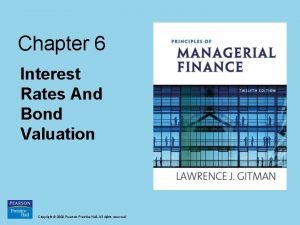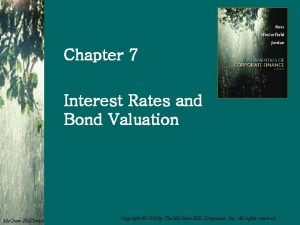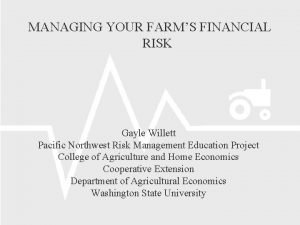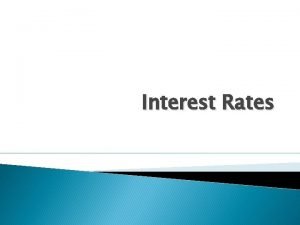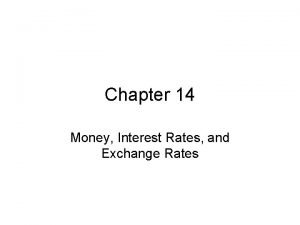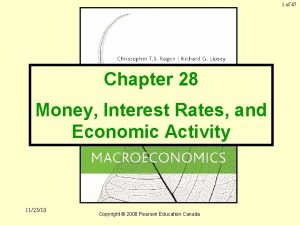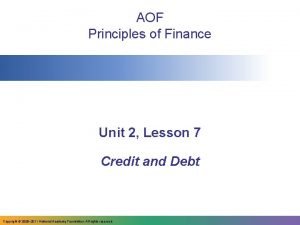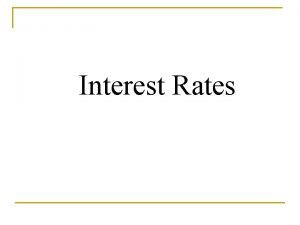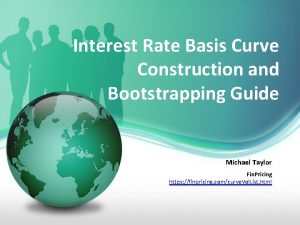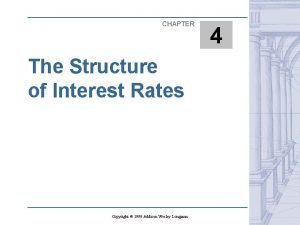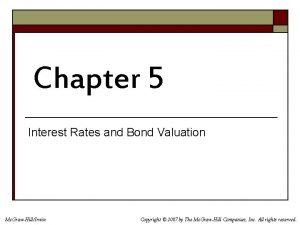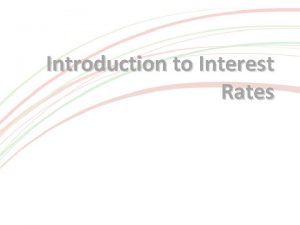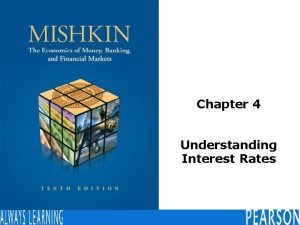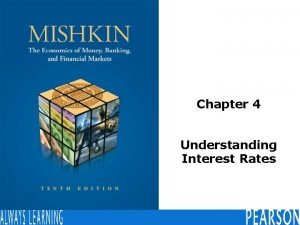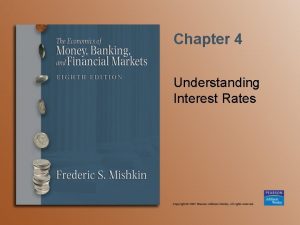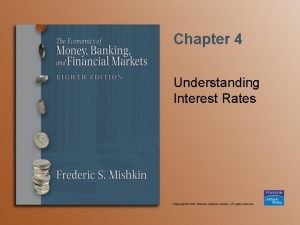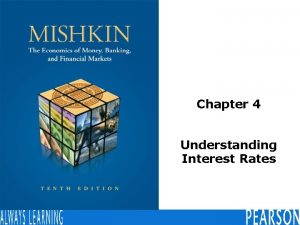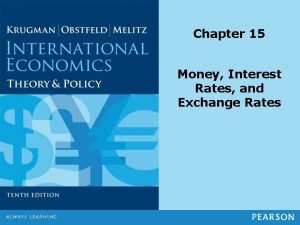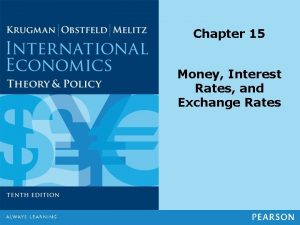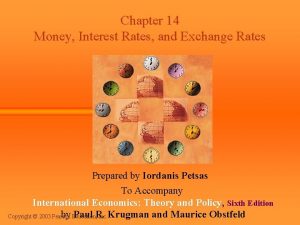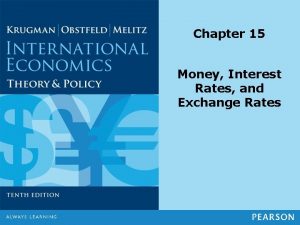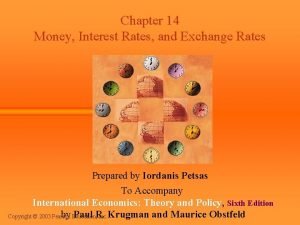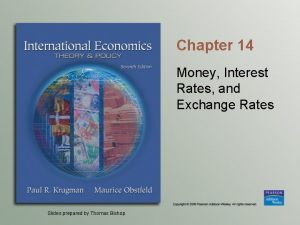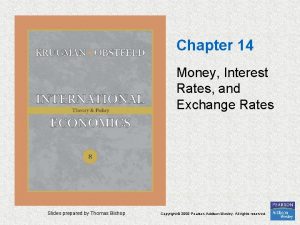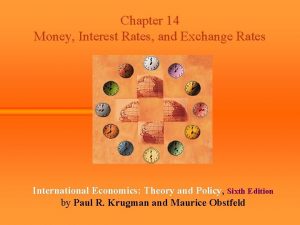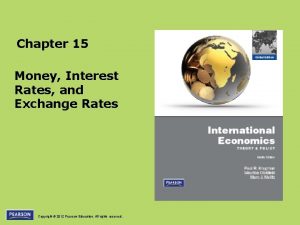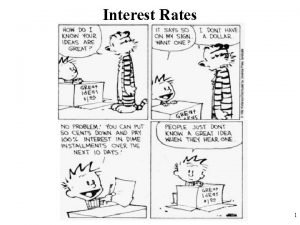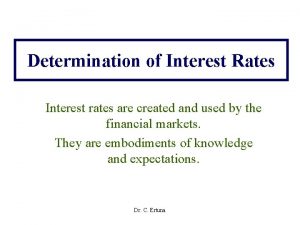The Cost of Money Interest Rates Chapter 5























- Slides: 23

The Cost of Money (Interest Rates) Chapter 5

The Cost of Money u Interest rates represent the prices paid to borrow funds u Equity investors expect to receive dividends and capital gains

The Cost of Money u 1. Production opportunities F returns available within an economy from investment in productive assets u 2. Time preferences for consumption F the preferences of consumers for current consumption as opposed to saving for future consumption

The Cost of Money u 3. Risk F the chance that a financial asset will not earn the return promised u 4. Inflation F the tendency of prices to increase over time

Interest Rate Levels u Supply and demand interact to determine interest rates between capital markets u Demand typically declines during business recessions, shifting the equilibrium rate down

Interest Rate Levels u Financial markets are interdependent

Interest Rate Levels u Financial markets are interdependent u Shifts in risk premiums, inflation rates, supply, and demand affect segments of the market differently

Determinants of Market Interest Rates u Quoted interest rate = F k = k* + IP + DRP + LP + MRP v k=the quoted or nominal rate v k*=the real risk-free rate of interest v IP=inflation premium v DRP=default risk premium v LP=liquidity, or marketability, premium v MRP, maturity risk premium

The Real Risk-Free Rate of Interest, k* u The rate of interest that would exist on default-free U. S. Treasury securities if no inflation were expected u Ranges from 1 to 4 percent in the U. S. in recent years

The Nominal Risk-Free Rate of Interest, k. RF u k. RF = k* + IP u The rate of interest on a security that is free of all risk, except inflation u Proxied by the T-bill rate or T-bond rate u k. RF includes an inflation premium

Inflation Premium (IP) u A premium for expected inflation that investors add to the real risk-free rate of return

Default Risk Premium (DRP) u Difference between the interest rate on a U. S. Treasury bond a corporate bond of equal maturity and marketability u Compensates for risk that a borrower will default on a loan

Liquidity Premium (LP) u Premium added to the rate on a security if the security cannot be converted to cash on short notice and at close to the original cost

Interest Rate Risk u Risk of capital losses to which investors are exposed because of changing interest rates

Maturity Risk Premium (MRP) u Premium that reflects the interest rate risk u Bonds with longer maturities have greater interest rate risk u Reinvestment rate risk

Term Structure of Interest Rates u Relationship between yields and maturities of securities u The graph is a yield curve

Yield Curve Figure 5 -4 1 5 10 20 Years to Maturity

Yield Curve u “Normal” Yield Curve F upward sloping yield curve u Inverted (“Abnormal”) Yield Curve F downward sloping yield curve

Term Structure Theories (Explanations) u Expectations theory F shape of the yield curve depends on investors’ expectations about future inflation rates u Liquidity preference theory F lenders prefer to make short-term loans rather than long-term loans (all else equal)

Term Structure Theories (Explanations) u Market segmentation theory F each borrower has a preferred maturity and the slope of the yield curve depends on the supply of and demand for funds in the long-term market relative to the short-term market

Other Factors That Influence Interest Rate Levels u Federal Reserve policy u Level of the federal budget deficit u Foreign trade balance u Level of business activity

Interest Rates and Stock Prices u Higher interest rates increase costs and thus lower a firm’s profits u Interest rates affect the level of economic activity and corporate profits u Interest rates affect investment competition between stocks and bonds

End of Chapter 5 The Cost of Money (Interest Rates)
 Dana damian
Dana damian Chapter 7 interest rates and bond valuation
Chapter 7 interest rates and bond valuation Your uncle would like to restrict his interest rate risk
Your uncle would like to restrict his interest rate risk Chapter 6 interest rates and bond valuation
Chapter 6 interest rates and bond valuation Chapter 7 interest rates and bond valuation
Chapter 7 interest rates and bond valuation Chapter 6 interest rates and bond valuation
Chapter 6 interest rates and bond valuation Unit rate
Unit rate Equivalent ratios definition
Equivalent ratios definition Ratios rates and unit rates
Ratios rates and unit rates Ratios rates and unit rates
Ratios rates and unit rates Interest rates and economic growth
Interest rates and economic growth Graphing monetary and fiscal policy interactions
Graphing monetary and fiscal policy interactions Disadvantages of high interest rates
Disadvantages of high interest rates Interest rates quotes
Interest rates quotes Increase money supply
Increase money supply Interest rates and price level
Interest rates and price level Nominal interest rate
Nominal interest rate Determinants of interest rates
Determinants of interest rates Economics unit 2 lesson 7
Economics unit 2 lesson 7 What is real interest rate and nominal interest rate
What is real interest rate and nominal interest rate Interest rates
Interest rates Interest rate curve construction
Interest rate curve construction Interest rates
Interest rates Interest rates
Interest rates



